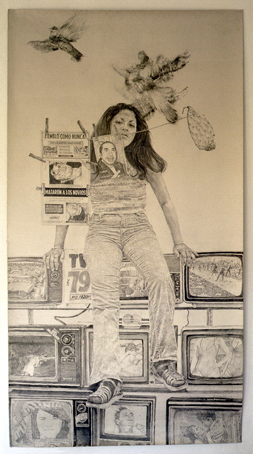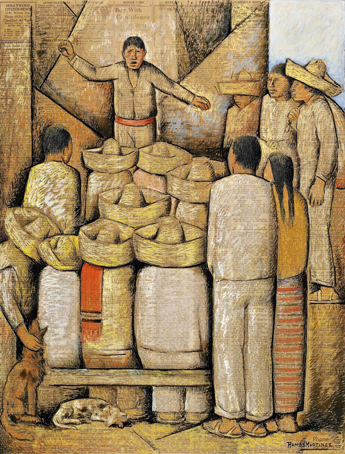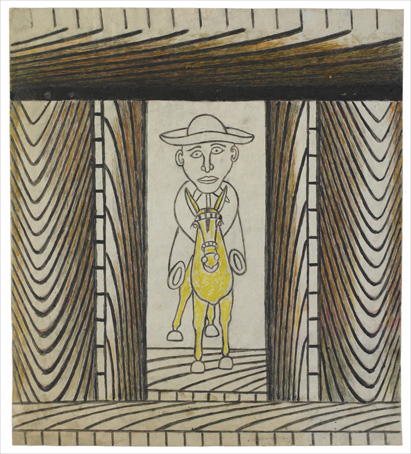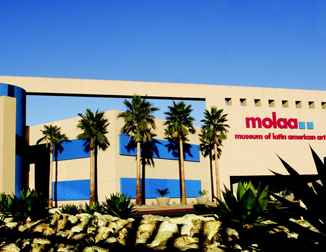
Gypsy Rose (date unknown)
Jesse Valadez
Jesse Valadez (Mexico, 1946–2011) became a founding member of the legendary Imperial Car Club in East L.A in 1965. He soon became an iconic figure of the lowriding world, earning the title of Lowrider Godfather of this cultural trend of elaborate paint schemes for cars. His most famous car, which wholly reflected his creativity and knowledge of the trend, was the Gypsy Rose, a fuchsia-colored 1964 Chevy Impala with its body adorned in multihued roses. Valadez led the club as president for over sixteen years and was enthusiastic about its involvement in the local community. In 2007 Lowrider Magazine named Valadez as that year’s recipient of its Lifetime Contributor Award. Gypsy Rose was also featured in the exhibition La Vida Lowrider: Cruising the City of Angels, at the Petersen Automotive Museum, Los Angeles, 2007–8.
Collection of Jesse Valadez, Jr Image courtesy of Estevan Oriol

Cholas, White Fence, East L.A., with Mexican Heroes Villa, Zapata, and Juarez (ca. 1986)
Graciela Iturbide
Silver gelatin print 20 x 24 in
Courtesy of Rose Gallery, Los Angeles, California © Graciela Iturbide

Sad Girl (1979)
John Valadez
John Valadez is a photorealist and muralist from Los Angeles, interested in representing the people of the Latino community—the cholos and cholas, street preachers, señoras, and so on—to validate their existence. His iconic Broadway Mural from 1981 presents a panoramic view of one of the most bustling streets in Los Angeles. His work includes large-scale drawings and photographs that are not only portraits of Angeleno characters but also serve at times as studies for figures in his murals.
Pencil on paper
Lena Torslow Hansen Collection, Los Angeles, California © John Valadez

Two Guys (1970-80)
John Valadez
Photographic print
Courtesy of the artist © John Valadez

La reunion/The Meeting (1932)
Alfredo Ramos Martinez
Alfredo Ramos Martínez moved with his family from Mexico City to Los Angeles seeking medical treatment for his sickly daughter in 1929. His impressionistic style shifts in California, incorporating the geometric and Art Deco elements of Los Angeles’s buildings to his murals and paintings, creating a dialogue between his proposal of modernism and the city. La reunión (The Meeting), 1932, belongs to a less-known body of work consisting of drawings made on the classified and personal pages sections of newspapers such as The Los Angeles Times, Hollywood Citizen News, and The New York Times, in which he broke away from his iconography of idealized bucolic figures to a portrayal of indigenous figures active in labor meetings, or signaling protest. Perhaps inspired by David Alfaro Siqueiros's presence in Los Angeles in 1932, Ramos Martínez’s figures become proto-Chicano statements about the racial and class struggles of the city, citing art historian Anna Indych-López.
Tempera, charcoal, and pastel on newsprint 21 x 16 in
Private Collection, Courtesy of The Alfredo Ramos Martanez Research Project © The Alfredo Ramos Martanez Research Project

086 Untitled (Man Riding Yellow Donkey) (ca. 1960-63)
Martin Ramirez
Martín Ramírez (Mexico, 1895–1963) explored the themes of confinement, exile, and poverty that he experienced as a Mexican living in the U.S. and as a mental patient. Ramírez migrated to Southern California from Tepatitlán in 1925, and in 1931 he was institutionalized at the Stockton State Hospital. He drew roughly 300 illustrative pieces, which make up his body of work from 1948 to 1963, during his confinement in the DeWitt State Hospital of Northern California. Ramirez’s works display an idiosyncratic iconography alluding to themes of Mexican folk art traditions and twentieth-century modernization.
Gouache, colored pencil, and graphite on paper
Image courtesy of Ricco/Maresca Gallery, New York © Estate of Martin Ramirez














